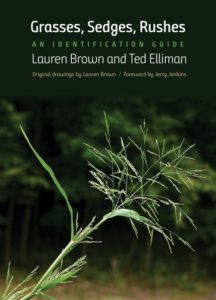 by Lauren Brown and Ted Elliman
by Lauren Brown and Ted Elliman
Published by Yale University Press
Reviewed by Charlie Wyman
Grasses have always scared me. Even as my copy of Gleason and Cronquist (Manual of Vascular Plants of Northeastern United States and Adjacent Canada) grew dirty and dog-eared through my college years as a biology major and afterward, the Gramineae pages stayed pristine. Too many species, the flowers too small, the terminology strange and unfamiliar. As an amateur naturalist and very part-time at that, as the demands of work and family limited my wanderings, I had come to terms with the fact that I’d die without knowing my grasses.
No longer. Lauren Brown and Ted Elliman’s little book, Grasses, Sedges, Rushes: An Identification Guide, has changed everything. Written for the amateur naturalist, it is what a field guide for the rest of us should be: simple, straightforward, getting us started, and giving us some satisfying successes without overwhelming us with a vast body of detail. It is an update of Ms. Brown’s classic work, Grasses: An Identification Guide, published in 1979, adding color photographs to the beautiful line drawings of the original, along with updated descriptions and several additional species.
This is not a comprehensive guide to the 800+/- species of grasses, sedges and rushes found in the Northeast and Upper Midwest. Instead, the authors highlight 141 species of grasses and grass-like plants that readers are most likely to encounter ” between their doors and the wild,” as Jerry Jenkins puts it in his forward.
To help users identify these more common species, Brown and Elliman provide several tools, which thankfully don’t have to be used in sequence, so if you stumble on one, you can turn to the others to help. An illustrated identification key steers you to small groups of species, along with a glossary to define the terms. There are the species descriptions themselves, typically one per page, including line drawings, color photographs, identification aids, notes on habitat, and comparisons with similar species. There are lists of species you are most likely to encounter based on habitat, flowering time, and size. When used in combination, these tools will often bring the amateur far more success and satisfaction, with far less stress, than the detailed keys of more comprehensive works.
For those who wish to dig deeper, there is a guide to other sources, including web resources, the comprehensive works that cover all the species of the region, and a more detailed glossary with helpful line drawing illustrations of many of the more technical terms used by taxonomists. A plus for this reader is a short, fascinating chapter on the ecology and history of the American Prairie.
If you want to know what that rare grass growing in an unusual environment is, you’ll need to go elsewhere. But if you want to demystify this confusing group of plants and learn what is growing outside your back door, down the street, or in a nearby natural area, this is a great place to start.
About the Reviewer
Charlie Wyman is an amateur naturalist living in Lexington, Massachusetts. Retired from a career as a project manager in the land conservation field, these days as part of Lexington Living Landscapes, he encourages fellow town residents to plant more native plants, give up their lawn chemicals, and plant more trees.
***
Each author appearing herein retains original copyright. Right to reproduce or disseminate all material herein, including to Columbia University Library’s CAUSEWAY Project, is otherwise reserved by ELA. Please contact ELA for permission to reprint.
Mention of products is not intended to constitute endorsement. Opinions expressed in this newsletter article do not necessarily represent those of ELA’s directors, staff, or members.

 by Lauren Brown and Ted Elliman
by Lauren Brown and Ted Elliman